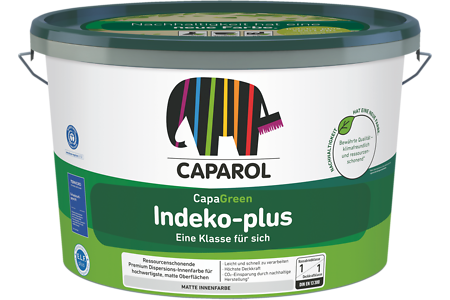Field of Application
Transparent special primer for exterior and interior use.Particularly suitable for gypsum substrates. For priming and solidifying/strengthening existing, superficially sanding render/plaster coatings. Also suitable for surfaces on which existing coats of paint have been removed by washing or mechanical means, as well as for substrates contaminated with residues of waste-paper or glue.
Do not use the product on ETICS/EWI systems with polystyrene (EPS) boards and on polystyrene containing renders/plasters.
Do not apply in areas used for storage or preparation of foods.
Material Properties
- Strengthening effect/consolidation of substrates.
- Deeply penetrating to the substrate.
- Allows diffusion and sorption.
- Alkali-resistant.
- Transparent (colourless) when fully dry.
Material Base / Vehicle
Acrylic resin in white spirit.Packaging/Package Size
1 l, 5 l, 10 l and 25 lStorage
Keep in a cool, but frost-free place.Density
Approx. 0.8 g/cm3Suitability according to Technical Information No. 606 Definition of Application Areas
| Interior 1 | Interior 2 | Interior 3 | Exterior 1 | Exterior 2 |
| ○ | + | + | + | + |
| (–) inapplicable / (○) of limited suitability / (+) suitable | ||||
Suitable Substrates
The substrates must be dry, clean, and free from all substances that may prevent good adhesion.In Germany: Follow VOB, part C, DIN 18363, section 3.
Substrate Preparation
Please follow our Technical Information No. 650 ("Substrate and their Preparation") for suitability of the product on various substrates and their required pre-treatment.Thinning
Only to be thinned/diluted with white spirit, if necessary.Surface Coating System
Application:In normal case: Apply one coat of unthinned product on normally absorbent substrates.
On friable, porous render/plaster surfaces: Apply two priming coats, wet-on-wet.
Thin up to a max. of 20 % with white spirit for priming substrates of low absorbency.
The primer must not form a closed, shiny film.
Consumption
Approx. 150 - 300 ml/m2 depending on substrate absorbency and thinning ratio/degree of dilution. Determine the exact amount of material required by coating a test area on site.Application Conditions
Lower Temperature Limit for Application and Drying:Tiefgrund TB is applicable even in frosty conditions, providing that the substrate is dry and ice free.
Drying/Drying Time
At +20 °C and 65 % relative humidity recoatable at the earliest after 12 hours.Lower temperatures extend the drying time.
Tools
Tiefgrund TB is applied by brush (work in well) or suitable airless equipment. Do not use compressed-air spraying machines.Airless Application:
Spray angle: 60°
Nozzle size: 0.029"
Spraying pressure: 50 - 60 bar
Tool Cleaning
Clean tools immediately after use with white spirit or brush cleaner.
Note
Always provide for a sufficiently long drying time when applied in sensitive areas.When using Tiefgrund TB in interiors, a typical solvent odour is released, hence proper ventilation must be provided during application and drying.
Use non-aromatic, low-odour AmphiSilan-Putzfestiger in sensitive areas
(see Technical Information No. 670).
Compatibility with other Paint Products:
Do not mix Tiefgrund TB with other products.
Special Risks (Hazard Note) / Safety Advice (Status as at Date of Publication)
Restricted to professional users.Flammable liquid and vapour. May be fatal if swallowed and enters airways. May cause drowsiness or dizziness. Harmful to aquatic life with long lasting effects.
Repeated exposure may cause skin dryness or cracking. Keep out of reach of children. Keep away from open flames/hot surfaces. - No smoking. Do not breathe vapours/ spray. Do not get in eyes, on skin, or on clothing. Use only outdoors or in a well-ventilated area. Avoid release to the environment. IF SWALLOWED: Rinse mouth. Do NOT induce vomiting.
Disposal
Materials and all related packaging must be disposed of in a safe way in accordance with the full requirements of the local authorities. Particular attention should be made to removing wastage from site in compliance with standard construction site procedures.In Germany: Only completely empty containers should be handed in for recycling. Dispose containers with residues of liquid product via waste collection point accepting old paints and enamels. Dispose dried/hardened product residues as construction site/demolition/municipal or domestic waste.
EU limit value for the VOC content
of this product (category A/h): max. 750 g/l (2010). This product contains max. 730 g/l VOC.Product Code Paints and Enamels
M-GF03 (Germany)Substances of Content - Declaration
Polyacrylate resin, aliphatic compounds, aromatics, glycol ether.Further Details
See Material Safety Data Sheet (MSDS).Technical Assistance
As it is impossible to list herein the wide variety of substrates and their specific problems, please request our technical assistance in case of queries. We will describe appropriate working methods, if a substrate not specified above is to be coated.Customer Service Centre
Tel.: +49 06154- 71 7 1710Fax: +49 05154- 71 7 1711
e-mail: kundenservicecenter@caparol.de
International Distribution: Please see www.caparol.com









